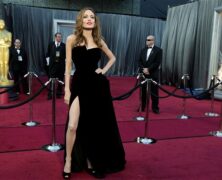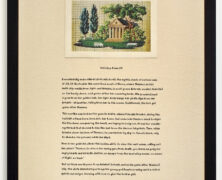For a long time, I was suspicious that Angelina Jolie wasn’t real. While there may be an actual person named Angelina Jolie, it wasn’t the person in films, on magazine covers or the “candid” shots on the web. In fact, I have never seen the real Angelina Jolie; she is an actor and as such, anytime a camera is trained on her, she disappears and performs “Angelina Jolie.” Part of this has to do with media oversaturation of course. With a consistent flow of films and tabloid narratives to satiate even the most rabid fan, there is a constant erasure of the Real. Through the sheer repetition of her face and body plastered everywhere – we recognize “Angelina Jolie;” her pose, facial expressions, gait, stance and manner of dress. The candid moments elide into the professional events of the brand known as Angelina Jolie, so much so that it becomes difficult to tell them apart. When she became Lara Croft in the 2001 “Tomb Raiders” film franchise, Jolie was perfectly believable as a fleshly apparition of the video game avatar because we believed knew her off-screen persona as a cold, femme fatale with softness on the side. In her more recent roles as Grendel’s monstrous mother in the CGI animation Beowulf and as the kick-ass ultra spy in Salt, she seems as real as we can possibly see her. That is to say, all of the sultry looks and commanding postures we see of her on-screen, visually matches her off-screen (or more accurately her print) persona. Not to overuse the phrase of the century but there really is no there there with Jolie and that has worked to her advantage. As an actor, the person is the product and whatever privacy is...
Gaga AKA The Real Phony...
posted by Christina Valentine
The identity and cultural role of Lady Gaga is reminiscent of a line in the film “Breakfast at Tiffany’s” (adapted from Truman Capote’s short story.) Holly Golightly’s agent, O.J. Berman quizzes Paul Varjack on the phoniness of Holly: Berman: Answer the question. Is she or isn’t she? Varjack: What? Berman: A phony. Varjack: I don’t think so. Berman: You don’t huh? Well, you’re wrong. She is. But on the other hand, you’re right, because she’s a real phony. She honestly believes all this phony junk. Lady Gaga resides and functions culturally as a “real phony.” A living simulation wherein what you see in the celebrity sphere is what she is 24/7, Gaga pushes the boundaries of the public/private identity as well as challenging the concept of the hyperreal. O.J. Berman’s question about being a phony is a prescient one because it reveals the conundrum of authenticity. How genuine is an identity that is based on an amalgam of others?[i] In the film, Breakfast at Tiffany’s, the query asks for a decisive judgment on authenticity, Berman’s own answer is reflective of our current navigation of identity and culture. The question: “Is she or isn’t she?” and the answer: “You’re wrong. She is. But on the other hand you’re right. Because she’s a real phony…” presents a situated identity. An identity that is at its core a “phony” but at the same time, always authentic, a “real phony.” It’s a good question, “is she or isn’t she?” The question is a barometer of how inauthentic one is. It’s the most appropriate question to ask when doing a cultural critique of Lady Gaga. Not to say that she is the Holly Golightly of our time – that would be presumptuous. However, the question remains, “is she or isn’t she?” This line of...
Epilogue: Art Object (Comes with Certificate of Authenticity) Or a Gift with Purchase....
posted by Christina Valentine
Some art works operate like a bluff. They challenge you to take them up on their offer – to call what they are as art and agree with their assigned cultural value. While there is the concept and theory that blankets the object in its meaning, at the core of an object is the viewer’s receptivity. For artist Jennifer Mills, every action by the viewer must be countered by an act on her part to maintain her role as saboteur. As her art practice encompasses all aspects of the art machinery (concept, production, exhibition, viewer) the work is not finished until we have measured and documented the audience and their actions. As part of her practice, all Mills’ objects are priced at $10 or below to counter the art industry’s valuation of works. Specifically for the series Art Object, the artist offered the entire set of objects for a more significant sum. Los Angeles Gallerist Steve Turner negotiated an undisclosed sum below the offered price and purchased the set. Herein lies the criticality behind the series of these moves: the viewer offers up a negotiated price challenging the artist’s stated worth, the artist agrees or disagrees and a sale is either gotten or forgotten. Quite often this is the end of the artist/patron cycle in the 21st century. But with Mills, the cycle expands to reflect on the business of art. Ms. Mills continues her series of detournements in this instance by generously offering the Gallerist a “gift with purchase.” She has co-opted a well-known promotional gesture within commerce – the offer of additional items for free. In this case, the offer consisted of mice to go along with the mousetraps which were the art objects purchased. For the artist, the circle of meaning...
A Little Dinner Conversation...
posted by Christina Valentine
Kate Durbin was robbed. It was a subtle theft, one that occurred with a polite denial on the part of the thief. Corporate theft of an artist’s intellectual property is something that happens often and very difficult to prove. The complete story about this thievery can be read here. What transpired after is her performative challenge, “N O Bikini,” and the derogatory comment left on her post – which leads us to the dinner conversation via Facebook. What kind of conversation is the run of texts on Facebook? Is it idle chatter? Banal, overused idioms that have polluted our daily conversations? At times, comments on a Facebook post can become criticism (even in its ad hoc state) and eventually, by nature of its form, a social commentary. Given these parameters, I give you a little dinner conversation. Brought to you by Facebook. Kate Durbin will be performing Prices Upon Request at our invitation only event, Zg Presents on June...
Unraveling Ariadne’s Thread: Works by Elaine Reichek...
posted by Christina Valentine
Catullus, Poem 64 A wonderfully embroidered cloth sets forth the mythic deeds of various men of old. It illustrates the wave-loud coast of Naxos, where Theseus and his swift ship vanish from sight, and Ariadne, in most grave distress, awakes deserted on the lonely shore, and gazes after her uncaring lover. The graceful band is gone from her golden hair, her light dress hangs, her girdle slips from her breasts—all scatter, falling from her in the waves. Indifferent, the lost girl gazes after Theseus. This warlike man had earlier gone to Crete, where Princess Ariadne, seeing him, had felt a flame burn down into her bones. And when bold Theseus went to fight the Minotaur, conquering the beast, and laying its body low, it was her wander- ing thread that showed to him the exit from the devious labyrinth. Then, when Ariadne chose the love of Theseus, he carried her by ship to Naxos’s shore, only to abandon the princess while she slept. Now in her grief she climbs the sudden cliffs, to view the vast ocean, calling out her plaint: “Theseus, in return for saving you from death, you leave me prey for angry beasts and birds. No shelter, no escape from the encircling waves, no means of flight, no hope.” But as these words pour from Ariadne’s breast, and as she gazes after Theseus’s ship, the cloth elsewhere portrays the young god Bacchus racing amid a riot of spirits and satyrs, burning with love to give the Cretan girl. WARBURG BACCHUS/VOLCANO RUINS ARIADNE SCULPTURES ...





